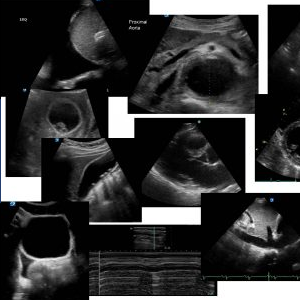Images Earl Butler, text Genevieve Carbonatto
A 55 year old lady presents with acute numbness to her right leg and “dizziness” lasting a few hours. No back pain. No chest pain. There are no other neurological symptoms. BP 175/85 HR 72/min, RR 16/min saturations 96% on room air. Because of the numbness in her leg and the acute nature of her symptoms a point of care ultrasound was performed to exclude an aortic dissection.
This is the mid aorta in the transverse plane. What can you see?
There is a dissection flap in the mid aorta.

An aortic flap may not always be visible with ultrasound. It will depend on it’s orientation to the ultrasound beam. If a dissection is suspected it needs to be examined from several angles in an effort to show the flap (1)
This is her aorta when colour Doppler was used. Describe your findings.
Colour Doppler shows the aorta in this plane divided into 2 by the dissection flap. As the blood pulsates through the aorta, flow is moving forward in the true lumen and backwards in the false lumen
Spectral and colour Doppler will show the presence and the character of the flow in both the true and false lumens. Even if the flap is not visible, the different flows in the 2 channels will be apparent on Doppler
Reversed flow may be seen in the non dominant channel due to compression in systole
If one channel is thrombosed it may be more confusing
This is a clip of the mid aorta in the longitudinal plane . What can you see?
The dissection flap is visible and pulsates with the aorta. It is always important to view the flap in 2 planes. Because the aorta is anechoic, artifacts are often seen within the aorta which may resemble dissection flaps. By viewing the structure in both the transverse and the longitudinal plane, a dissection flap can be differentiated from an artifact.
Chronic dissection flaps are often thicker and straighter than those seen in acute dissections.

This is the longitudinal view with colour Doppler. Describe what you see.
Colour Doppler shows 2 channels. The flow is bidirectional. Flow in the true lumen is blue as blood moved down the aorta. Flow in the false lumen is red as it is moving back up the aorta.
The best imaging modality for dissection is CT scanning. How can you differentiate the true lumen from the false lumen with CT ?
Differentiation between the true and false lumen is important especially for the placement of an endoluminal graft. If there is no clear continuation of one lumen with the artery then it can be difficult. The following features may distinguish one lumen from the other.
True lumen
- The true lumen is often compressed by the false lumen and the smaller of the two
- The true lumen has outer wall calcification (helpful in acute dissections)
- The origin of celiac trunk, SMA and right renal artery usually arise from true lumen – best seen on CT
False lumen
- It is often the larger lumen in size due to higher false luminal pressures.
- A Beak sign can be seen on a CT scan (is the acute angle formed at the edge of the false lumen in aortic dissection in axial cross-section. It is formed by the borders of the outer aortic wall and the intimal flap, and may be partially thrombosed (blunted beak). It is a reliable characteristic that helps in distinguishing from the true lumen).
- The Cobweb sign (this refers to slender linear areas of low attenuation specific to the false lumen due to residual ribbons of media that have incompletely sheared away during the dissection process).
- The false lumen has often lower contrast density due to delayed opacification.
- It may be thrombosed and seen as mural low density only (more common in chronic dissections).
- The origin of left renal artery usually arises from the false lumen.
- The false lumen ususally surrounds the true lumen in Stanford type A dissectons.
- Chronic dissection flaps are often thicker and straighter than those seen in acute dissections
References
- Clinical Ultrasound : Paul Allen
- Management of acute aortic dissection and thoracic aortic rupture Toshihiro Fukui Journal of Intensive Care20186:1
- Up to date : aortic dissection
- Gen Thorac Cardiovasc Surg. 2019 Feb;67(2):203-207. doi: 10.1007/s11748-018-1030-y. Epub 2018 Nov 19.
Acute medical management of aortic dissection - Medscape :Acute aortic dissection
- Radiopaedia : Aortic dissection





